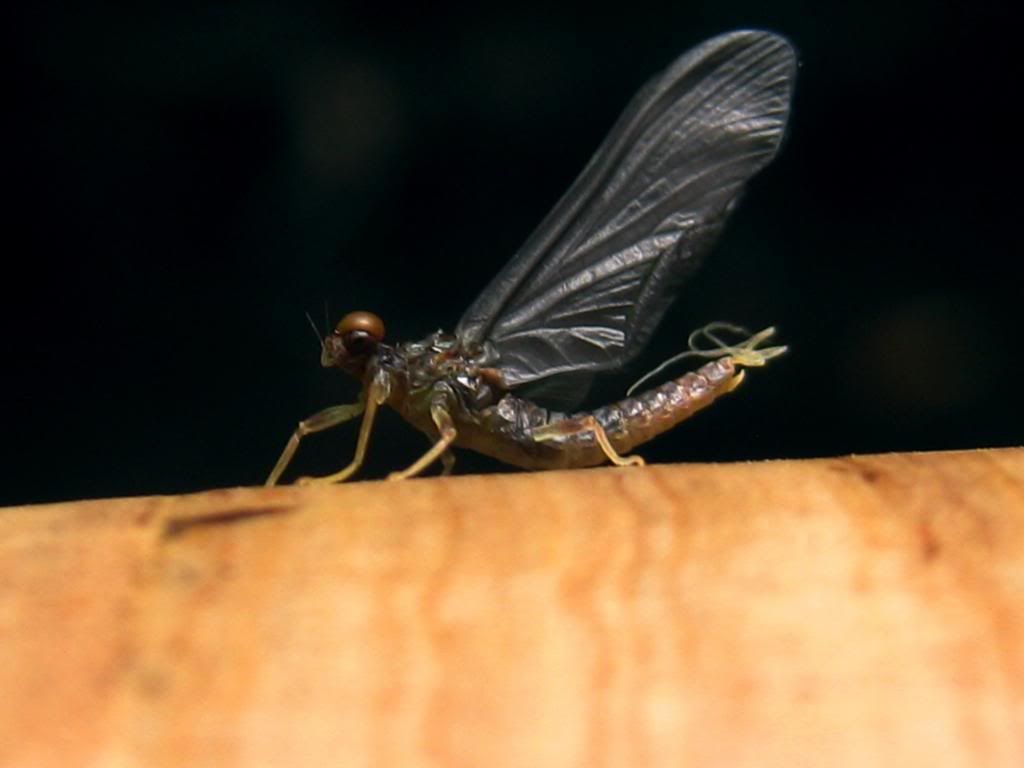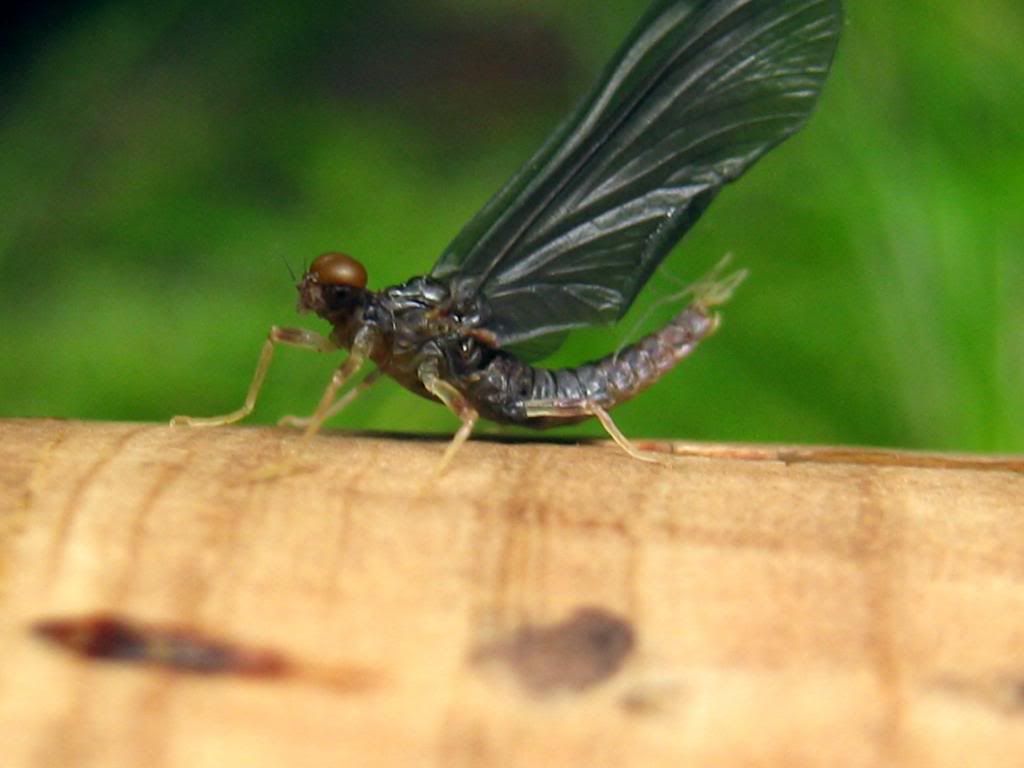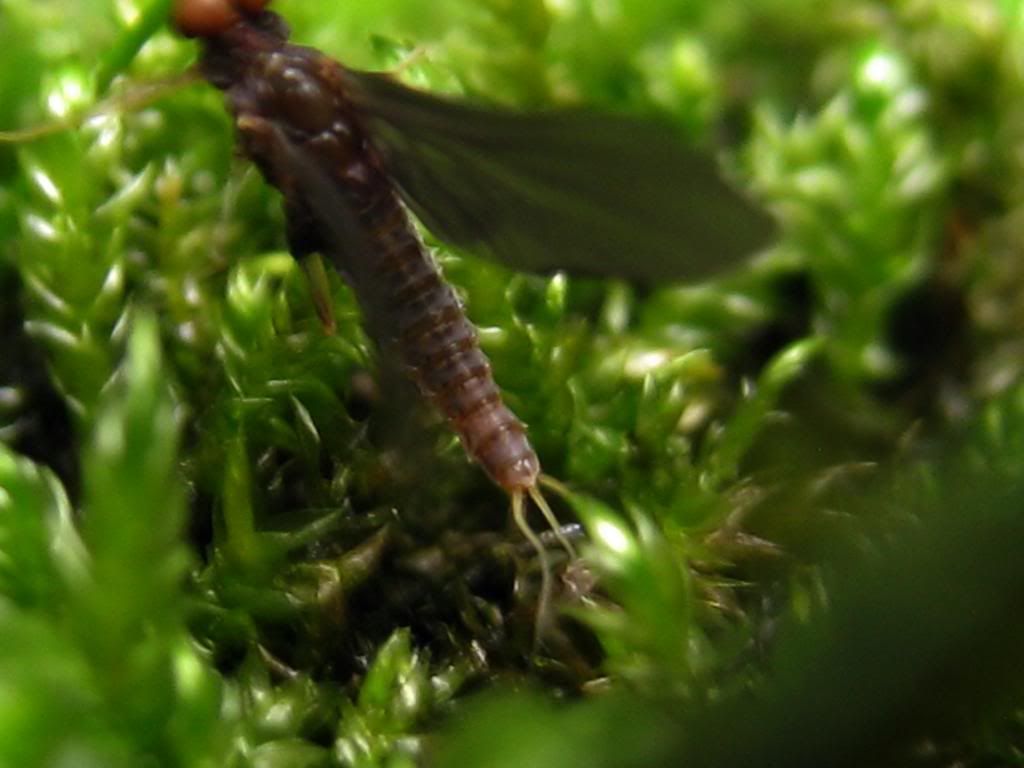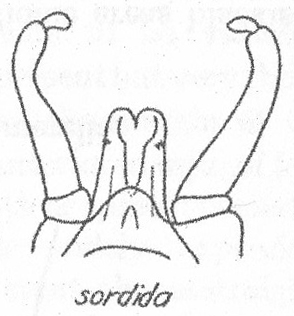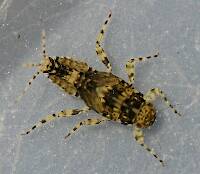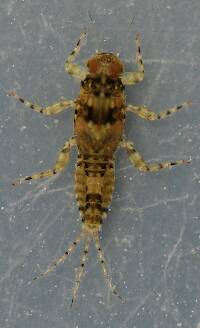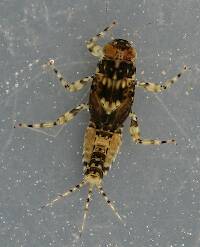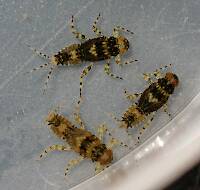
Salmonflies
Pteronarcys californica
The giant Salmonflies of the Western mountains are legendary for their proclivity to elicit consistent dry-fly action and ferocious strikes.
Featured on the forum

This wild-looking little thing completely puzzled me. At first I was thinking beetle or month larva, until I got a look at the pictures on the computer screen. I made a couple of incorrect guesses before entomologist Greg Courtney pointed me in the right direction with Psychodidae. He suggested a possible genus of Thornburghiella, but could not rule out some other members of the tribe Pericomini.

Troutnut is a project started in 2003 by salmonid ecologist Jason "Troutnut" Neuswanger to help anglers and
fly tyers unabashedly embrace the entomological side of the sport. Learn more about Troutnut or
support the project for an enhanced experience here.
Taxon on Aug 26, 2013August 26th, 2013, 12:00 pm EDT
Hi Eric-
I believe it to be an Attenella attenuata male subimago.
I believe it to be an Attenella attenuata male subimago.
Entoman on Aug 26, 2013August 26th, 2013, 1:58 pm EDT
Seems too dark to me, Roger. How about Serratella serrata (Little Sooty Olive), guys? Based on the eye color and leg markings, my other guess would have been Eurylophella bicolor (Little Dark Claret, Schwiebert) but the 9th seg is too short.
"It's not that I find fishing so important, it's just that I find all other endeavors of Man equally unimportant... And not nearly as much fun!" Robert Traver, Anatomy of a Fisherman
Crepuscular on Aug 26, 2013August 26th, 2013, 2:56 pm EDT
I love posting these because my best guesses (and that's all they were, based on size) were both of those. ha. And I wasn't sure of either. I'll see if I can get an imago. The Eurylophella crossed my mind too but like you pointed out, the 9th is seems to be too short. I even thought about D. lata.
PaulRoberts on Aug 26, 2013August 26th, 2013, 6:09 pm EDT
I'm thinking (guessing) Serratella too.
Taxon on Aug 26, 2013August 26th, 2013, 7:34 pm EDT
Crepuscular on Aug 27, 2013August 27th, 2013, 3:58 am EDT
Cool Rodger. Where is that character described? Do you think the elongated forceps of the Attenella sp.(McCafferty 1977) are there in the sub imago? If they are, the terminal (3rd) segments of this one are not elongated. It seems to me that this elongation is such that it would be there even in the subimago. But I don't have any experience with this, so I'm flying by the seat of my pants here.
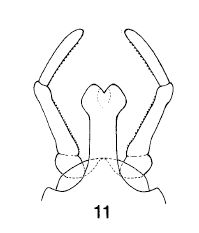

Taxon on Aug 27, 2013August 27th, 2013, 6:40 am EDT
Hi Eric-
Don't recall having encountered a description of it.
I would think so, but the resolution of your photos is not adequate to clearly enough see the forceps in order to make any useful comparisons.
Where is that character described?
Don't recall having encountered a description of it.
Do you think the elongated forceps of the Attenella sp.(McCafferty 1977) are there in the sub imago?
I would think so, but the resolution of your photos is not adequate to clearly enough see the forceps in order to make any useful comparisons.
Crepuscular on Aug 27, 2013August 27th, 2013, 7:16 am EDT
I would think so, but the resolution of your photos is not adequate to clearly enough see the forceps in order to make any useful comparisons.
No I know, but you'll have to take my word for it, I looked at it under my scope. It's not elongated.
Taxon on Aug 27, 2013August 27th, 2013, 2:58 pm EDT
Konchu on Aug 27, 2013August 27th, 2013, 5:15 pm EDT
Don't know about timing in PA, but it looks alot like Teloganopsis deficiens, off the top of my head. If this were earlier in the year, I'd have some other suspects. The leg markings and dark purple color look like T. d. I'd have to check the size. Are the tails really unbanded? Some of the apparently darker middle abdominal terga would be characteristic of some Serratella spp., though.
Crepuscular on Aug 27, 2013August 27th, 2013, 5:33 pm EDT
Crepuscular on Aug 27, 2013August 27th, 2013, 5:34 pm EDT
Don't know about timing in PA, but it looks alot like Teloganopsis deficiens, off the top of my head. If this were earlier in the year, I'd have some other suspects. The leg markings and dark purple color look like T. d. I'd have to check the size. Are the tails really unbanded? Some of the apparently darker middle abdominal terga would be characteristic of some Serratella spp., though.
Tails are unbanded. 6.5mm
Entoman on Aug 27, 2013August 27th, 2013, 7:10 pm EDT
Don't know about timing in PA, but it looks alot like Teloganopsis...
Hmm... My initial impression as well with those dark wings, but discounted the possibility over size and tail maculation. Can they get this big?
"It's not that I find fishing so important, it's just that I find all other endeavors of Man equally unimportant... And not nearly as much fun!" Robert Traver, Anatomy of a Fisherman
Entoman on Aug 28, 2013August 28th, 2013, 10:25 am EDT
Taxon -
Awhile back I remember posting on this character in the hope that it would prove as useful for ephemerellids as it is with baetids. Unfortunately, I haven't come across any evidence to date that it is. Hopefully Konchu will address this.
BTW - I'm not sure that isn't an artifact in the photo. It looks like it may just be an area of the suture that caught more light against the dark background of the mesonotum for some reason.
This structure (tubercle?) on the pronotum may provide a useful clue as to genus...
Awhile back I remember posting on this character in the hope that it would prove as useful for ephemerellids as it is with baetids. Unfortunately, I haven't come across any evidence to date that it is. Hopefully Konchu will address this.
BTW - I'm not sure that isn't an artifact in the photo. It looks like it may just be an area of the suture that caught more light against the dark background of the mesonotum for some reason.
"It's not that I find fishing so important, it's just that I find all other endeavors of Man equally unimportant... And not nearly as much fun!" Robert Traver, Anatomy of a Fisherman
Martinlf on Aug 28, 2013August 28th, 2013, 5:10 pm EDT
Looks like Teloganopsis to me. See the "Black Quills" thread.
"He spread them a yard and a half. 'And every one that got away is this big.'"
--Fred Chappell
--Fred Chappell
PaulRoberts on Aug 28, 2013August 28th, 2013, 5:47 pm EDT
Teloganopsis??!! Wake me in a century.
Entoman on Aug 28, 2013August 28th, 2013, 7:55 pm EDT
Paul - Yeah, perhaps Luke can explain why the need for a genus name so seemingly unrelated and strange sounding for an ephemerellid. My assumption is that our bug was found to be more closely allied with an old world genus already named. Teloganopsis single nearctic species was (until very recently) known as Serratella deficiens (prev. Ephemerella deficiens). Recent nomenclature changes aside, in my book your initial opinion is valid regardless the species it may turn out to be.:)
Louis - The two are very similar dark little ephemerellids and telling them apart is difficult. To make it even more difficult, they are apparently often found hatching together where their ranges overlap. It is my understanding that T. deficiens is usually well under 6 mm while S. serrata is usually well over. The former is described as being a little darker overall (almost black wings as duns) with pale legs and ringed tails. The latter is described as having more somber eyes, darker legs and with plain tails (the sordida form). Both can have subtle leg maculation. Though these are spinner descriptions, they probably still apply. Don't know about the other characters but I believe the presence or absence of tail annulations are diagnostic between the two.
Anyway, that was the rationale for my guess.:) What I do know is that it's a small dark ephemerellid. Little Dark Red Quill is what I'd call it.
Louis - The two are very similar dark little ephemerellids and telling them apart is difficult. To make it even more difficult, they are apparently often found hatching together where their ranges overlap. It is my understanding that T. deficiens is usually well under 6 mm while S. serrata is usually well over. The former is described as being a little darker overall (almost black wings as duns) with pale legs and ringed tails. The latter is described as having more somber eyes, darker legs and with plain tails (the sordida form). Both can have subtle leg maculation. Though these are spinner descriptions, they probably still apply. Don't know about the other characters but I believe the presence or absence of tail annulations are diagnostic between the two.
Anyway, that was the rationale for my guess.:) What I do know is that it's a small dark ephemerellid. Little Dark Red Quill is what I'd call it.
"It's not that I find fishing so important, it's just that I find all other endeavors of Man equally unimportant... And not nearly as much fun!" Robert Traver, Anatomy of a Fisherman
Crepuscular on Aug 29, 2013August 29th, 2013, 4:56 am EDT
I know Louis has experience with Teloganopsis. My initial reaction was that this seemed too big and too light. But like I said, he's got first hand experience with a fishable hatch of these Ephemerellids. I have no experience with them. So if I had posted this a few years ago Seratella would have been correct. ;)
Martinlf on Aug 29, 2013August 29th, 2013, 6:56 am EDT
Kurt, and Eric, thanks. I don't have experience with S.serrata, and actually hadn't heard of it. So perhaps this bug is not a Telo. Does anyone have any information on the range of S.serrata? I know Teloganopsis hatches around here, but haven't ever heard anyone mention S.serrata. That doesn't mean they aren't around, and if they are it may explain some of the size variation I mentioned in the "Black Quills" thread. On the water the light legs of Teloganopsis look almost white at times. Is this true of S.serrata? The legs in Eric's photo looked pretty light to me. But Eric says the tails are unbanded, so that seems to knock out Teloganopsis. And I do typically see them earlier. Does anyone have hatch date info. for both species? It seems it may be S.serrata after all?
"He spread them a yard and a half. 'And every one that got away is this big.'"
--Fred Chappell
--Fred Chappell
Quick Reply
Related Discussions
Topic
Replies
Last Reply
4
Dec 22, 2009
by Oldredbarn
by Oldredbarn
3
Jan 16, 2007
by Martinlf
by Martinlf
16
Sep 22, 2011
by Oldredbarn
by Oldredbarn



